Notre Dame’s continued offensive struggles created a tight game for most of the visit to Louisville, but as the defense wore down and the Irish offense failed to created much efficiency or explosiveness the Cardinals pulled away late in the second half. The ND offense had an extremely poor performance – just 4.2 yards per play, below average efficiency, and allowed Louisville to create consistent havoc and negative plays.
Some editorial decisions had to be made about garbage time – by SP+ definitions, this game never went into garbage time (down more than 21 in the 4th). Still, late in the 4th quarter down multiple possessions there was all kinds of debris – Notre Dame turnovers, scoring drives, and Louisville sitting on turnovers (via downs and interceptions and fumbles) to happily kick field goals. So the final ~4 minutes (after Louisville went up 30-13) were excluded from the efficiency and explosiveness analysis below. The garbage time numbers (6.1 YPP for ND, 2.7 for Louisville) will make the final totals look better for the Irish, but they don’t seem representative of the regular game-state to me.
Stats from a few excellent sources – College Football Data, Game On Paper, and often referencing SP+ and FEI numbers. If you get lost, check out this handy advanced stats glossary here or reach out in the comments.
Notre Dame’s offense bottoms out (hopefully)
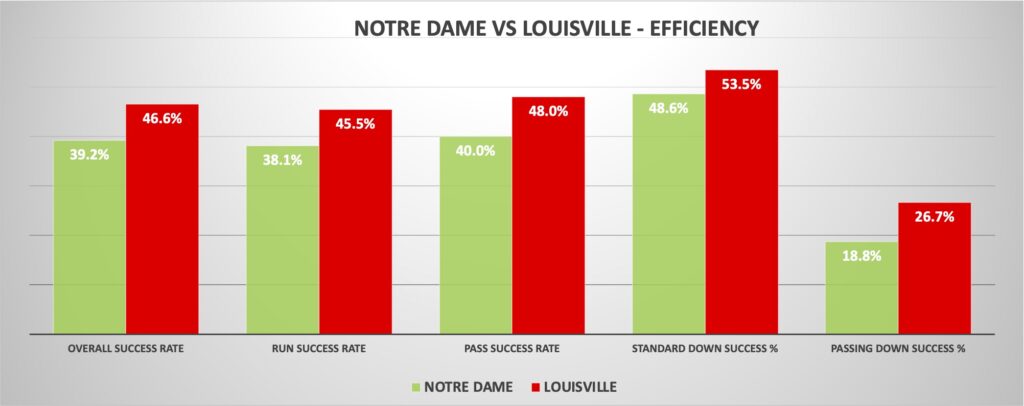
Let’s do the numbers part first – if we zoom all the way out, Notre Dame’s offense on this two-game ACC road trip has struggled mightily because it’s not particularly efficient or explosive. The Irish also haven’t been opportunistic converting scoring chances – a natural consequence to the inefficiency, but hey, sometimes you get lucky with stringing the rare good plays together. Before a late garbage time touchdown, there was only 1 of 12 ND drives that gained more than 30 yards!
It was bleak stuff against a defense that’s solid but liable to give up explosive plays. The Irish offensive success rate was at a very good level (50%) in the first half but averaged just 4.6 yards per play – possible only with a lack of explosives and significant number of negative, drive-killing plays.
The tempting explanation is to blame the MASH unit at wide receiver – one that saw Jayden Thomas and Jaden Greathouse return this week but clearly not 100% and on limited snaps. But while that situation isn’t great, Notre Dame’s offense is struggling across every facet right now – passing, rushing, power run situations in short yardage, long passing downs – you name it. Defensive coordinators can employ the same strategies they used against Drew Pyne right now against Sam Hartman and company – crash down relentlessly against the run, dare receivers to win one-on-one, and count on enough sacks or turnovers to snuff out any long drive.
If we break down the offensive staff’s in-season responsibilities, you could condense them into a few key themes:
- Understand your players and team’s strengths and leverage them through your scheme
- Design, implement, and adjust game plans for your opponent
- Develop players and enable them to execute at a high level
- Optimize your chance at winning through strong in-game decision-making (clock management, go versus kick, etc)
The game at Louisville was a case study in all of these things going wrong, when even failing at one is a major issue. I could post all kinds of numbers about win probability and EPA about the decisions to kick field goals early then go in terrible situations late. But the numbers aren’t really needed in this case – it’s evident that after a fairly solid start, Freeman and Parker have lost confidence and a cohesive philosophy when it comes to these key in-game decisions.
You don’t (or at least shouldn’t) come to this space for X and O’s expertise, but the ones I trust confirm what my eyes see – that Gerad Parker’s offense is making life extremely hard for itself. The interior offensive line rotation in the middle of Game 7 on the road is terrifying, there’s virtually no pre-snap motion or eye candy to mislead a defense, and rarely time to check into a more favorable play. Even when play-action is used, it doesn’t appear to fool defenses at all because of the poor execution and predictability of personnel and formations.
The upside is that when so much is going wrong, there’s some low-hanging fruit for improvement just by fixing one or two elements. Deciding to play for touchdowns versus field goals may be easier when you know USC is going to put points on the board. As Marcus Freeman alluded to in his Monday press conference, simply executing better will make a difference. And hopefully the failures on 3rd downs and short yardage spur new ideas and less predictability.
It will be fascinating to see where Parker turns next. Hartman has found a favorite interim target with the wide receiver mess in Mitchell Evans, who shined for a second straight game. But even that advantage seemed to have a shelf life as Louisville began dedicating more attention to Evans in the second half. Jeremiyah Love also has to see his role increase – in the struggles in Durham and Louisville the freshman has shined, averaging 8 yards per touch across the two games (while in this same stretch a visibly banged-up Audric Estime has just 4.1).
The Irish defense starts strong, then hung out to dry and fades late
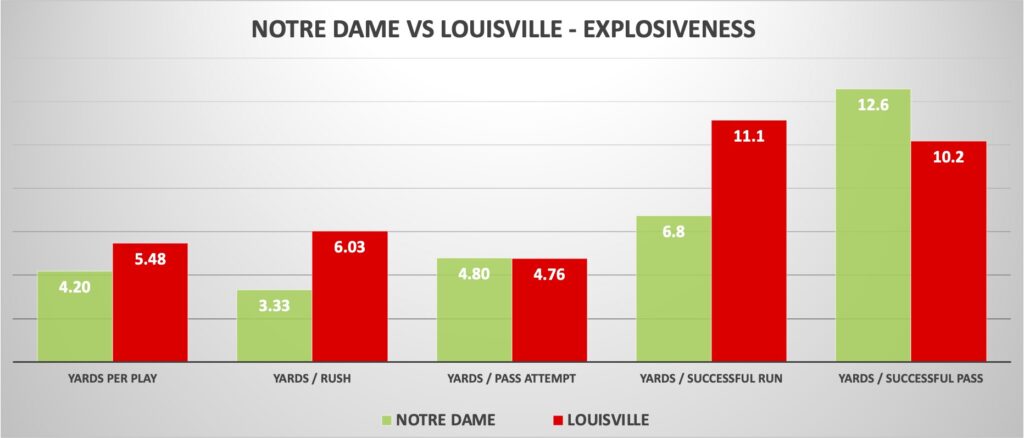
Al Golden’s defense surrendered a touchdown on the Cardinals opening drive, with the Brohm brothers pulling all out all kinds of early tricks. After that initial series, however, Notre Dame’s defense clamped down, holding Louisville to just 4.0 yards per play in the first half despite decent efficiency. They started the second half on the same note, gifting the offense a free scoring opportunity with Cam Hart’s strip and recovery on the first Louisville drive.
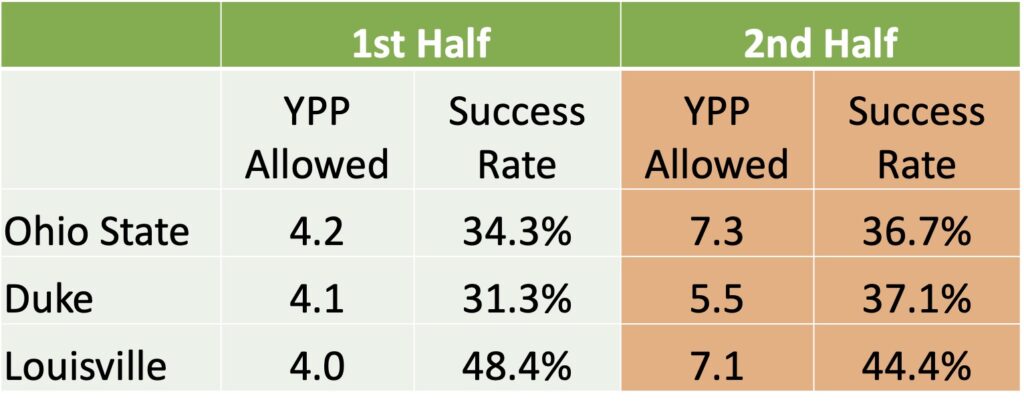
Part of the late-game issues come back to thin spots on the roster that have been a concern since spring. The pass rush has been serviceable but Vyper is shaky between Jordan Botelho’s inconsistency and the youth and inexperience of Josh Burnham and Junior Tuihalamaka. It’s a major issue when Howard Cross comes off the field, simply because the defense needs all their playmakers. When JD Bertrand missed a game the defense looked out of sync. DJ Brown is a solid player, but not someone Notre Dame should need to play every down in these critical games, and his limitations / fatigue showed up in costly ways.
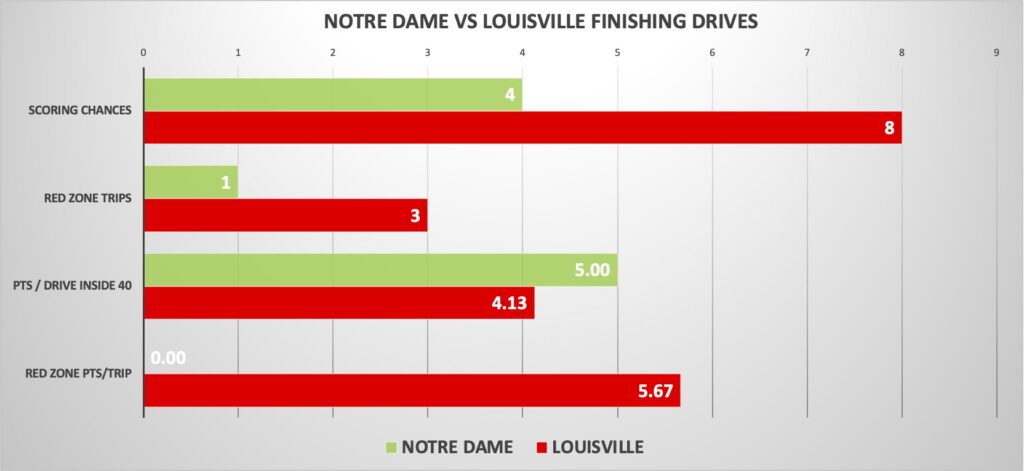
The full-game numbers are a little deceiving for the Irish defense. They’re saddled with 33 points allowed and scoring chances surrendered on 8/13 drives with many of those opportunities gift-wrapped by ND turnovers. However, on a per-play basis the defense also benefits from the garbage time Cardinals offensive possessions, where Jeff Brohm opted just to run the ball the bleed clock and kick field goals with a multiple possession advantage late.
Two things I believe can be true coming out of this – Notre Dame’s defense played well enough to win, and the defensive decline in the second half is probably the result of a few factors coming together – fatigue, thin depth, and allowing efficient offense without Louisville finding an explosive play not being sustainable. Priority one was containing the Cardinals explosive passing game, and that test was passed with flying colors. But Jawhar Jordan and company still rushed the ball efficiently and then late in the game hit the explosive runs to take and extend the lead.
Notre Dame’s defense isn’t the problem – it’s not a complete and dominant enough unit to win these types of games on their own, and with the talent on offense that shouldn’t be required.
An offensive overhaul may make or break this coaching regime
An offseason post that unfortunately still sits in the drafts folder was titled “Gerad Parker is ‘Choosing Hard’ with the OC Hire”. It was not so clever play on the “Choose Hard” recruiting pitch the Irish staff has leveraged to ask recruits to think big and take on a greater challenge with the combination of football and academics in South Bend. But the point of the unfinished post was that while no one knew how Parker would work out, even some of the better outcomes would likely carry some short-term pain and require time to reap the benefits.
I was dead wrong about one aspect – I thought that recruiting on offense could take a hit, especially at QB and the WR position, after promoting a relatively unknown OC. It seemed like one of the missed opportunities of the Tommy Rees era that never gained momentum – that without a track record of great passing offenses, he struggled to land elite QB prospects, which in turn meant he also couldn’t point to a superstar mentee in college or the NFL like other programs. To his credit, Parker and the offensive staff have put in the work and (before signing day at least) landed some top of the board targets.
But the rest of this gamble is playing out how I feared. Even if Parker may be an above-average OC in two or three years, there’s no margin for error or tolerance for growing pains that Freeman can weather. Winning is too hard, and competition for talent is too fierce. Developing an elite passing offense with explosive receivers is still the biggest cheat code and accelerator for success, and betting on Parker also represented an ability to quickly build the relationships and reputation to attract this kind of talent both from high school and the transfer portal.
I don’t think it’s hyperbole to suggest that the decision about OC this offseason has a good chance at deciding Marcus Freeman’s future fate. One poor coordinator hire nearly sank Brian Kelly’s tenure on campus despite an infinitely longer track record of success. And even with Van Gorder, Kelly (and whoever else was involved) held off on the tough decision too long, in part because the results in the standings weren’t so glaringly bad his hand was forced.
I worry that Freeman may be coming to a similar crossroads. Either the offense will underperform so much that losses puts him on the hot seat and force significant offseason change, or there’s enough improvement and somewhat defensible final record (especially in the softer 3-game final stretch) to claim things are heading the right direction and not make a change that looks bad for everyone involved in the hiring.
On to USC
Despite the struggles of the last two weeks, the Irish are slight favorites or a true toss-up in most projection models as the undefeated but flawed Trojans come to town. Gerad Parker vs. Alex Grinch, feel the excitement! This could be a case study for “what the stats don’t know” with Notre Dame’s receiver injuries, the offensive line in flux, and Sam Hartman looking out of sorts. But the sportsbooks – which accounts for these things – still agrees. Hopefully this is a “Vegas knows” situation, where the oddsmakers can see past our reactionary habits, but we will see.
It’s hard to imagine the Irish offense winning a shootout against Caleb Williams and Lincoln Riley, and playing a shorter game likely helps the tired and thin defensive roster as well. Can Notre Dame re-establish competence in the run game, or find some explosive plays against a very vulnerable SC defense? Unlike last year, can the defense “break serve” against Williams – and contain the rushing attack that consistently put the Trojan offense in favorable situations?

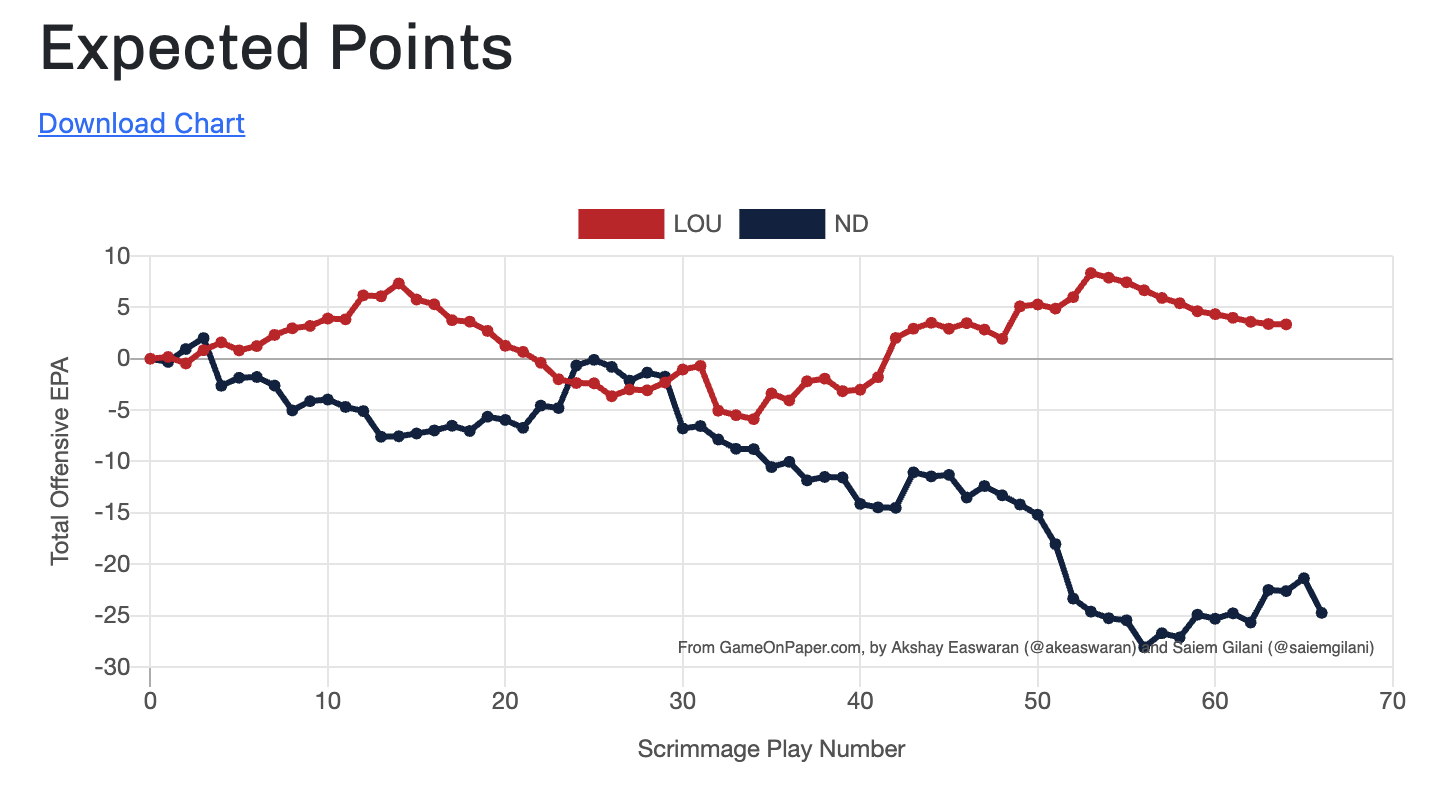
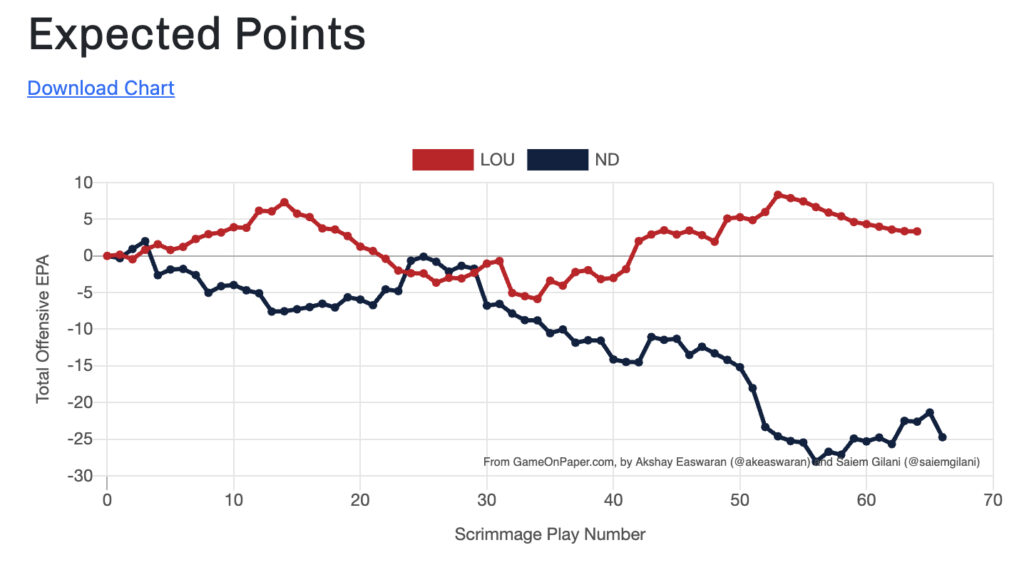



On Parker’s fate:
I think of him as an interim hire. He has all the characteristics of an interim — after the guy we really wanted went elsewhere, the timing to get someone else was bad, so we just promoted someone on staff who had sorta, kinda, maybe done this job before.
Sometimes interims end up getting the full-time job, but the presumption is that they won’t, and that they’ll be replaced in the next normal hiring cycle.
So far, Parker has not done nearly a good enough job to warrant full-time consideration. I guess it’s possible he might in the last 5 or 6 games, but it doesn’t seem likely. The presumption should be that we’re moving on in December.
Hey, Brian Ferentz may be available!
We need the Brian Kelly screaming emoji here.
Agree, we were just waiting to make sure 2022 wasn’t a fluke, and that Charlie Weis Jr. was the real deal at the Power 5 level.
Can we get Dric some f*ing cheeseburgers this week?
Very much agree with your assessment of how the OC needs to assess and leverage team strengths. Somehow Tommy Rees was able to figure out how to make Drew Pyne…OK at least. It helped that the instructions were “throw the ball to Michael Mayer every time and hope”, but Tommy figured out that was about what Drew Pyne was capable of. That, and leveraging Logan Diggs (who’s doing pretty well as RB1 now) and Estime.
How the heck Parker can’t figure out how to get his receivers in position to catch balls from Sam Hartman baffles me. Are our receivers worse overall than Drew Pyne at their respective positions?
Rees seems to have been a far superior OC to Parker. At least for one year with Hartman, it would have been great to see what Rees could have come up with.
probably something marginally better while not enough to beat Lousiville but as baffling and frustrating in more creative ways
I don’t think Rees gets enough credit for the good he did in figuring out ways to use his players – especially with such handicaps last year at QB. There’s no way we lose to a bad Lousiville defense with Rees calling plays. With Parker, it almost seems like this is high school level playing-calling bad. The defense does one thing to take us out of what we wanted to do initially and we have no counter. Rees – for whatever his faults (and let me be clear that I don’t mean to say he’s necessarily some kind of elite coordinators) – had counters for what defenses did to him. Parker seems to have none.
I think with Rees calling the plays we’d be undefeated right now and the offense would look pretty good. In fact, most OC’s who are able to have basic counters to what defenses do to them would have given us an undefeated season so far.
We scored 14 points against Stanford last year with Tommy as our OC. I think it’s a bit much to assume Tommy would have us undefeated so far.
Do you really think the talent he had to work with last year is equal to the talent he would have had to work with this year?
And do you realize that a few tweaks and one more score in one game and some counters in another game against a bad defense would likely make us undefeated? (In other words, it wouldn’t have taken much.)
No, the talent wasn’t as good (although I would note that Michael Mayer and Jaret Patterson would certainly be nice to have on this year’s team).
But Stanford had the #103 SP+/#94 FEI Defense. Louisville has the #18 SP+/#30 FEI Defense.
Also, Tommy just had a game this year where his offense only scored 17 points against the #127 SP+ Defense.
Thank you. It is ridiculous to assume that, also it isn’t the germane question. It’s not “But what if we had a slightly different intern OC?” It’s “What if ND actually got serious about offensive football and hired an OC who has ever done this in his professional life?”
Who created those handicaps at QB? Probably the QB coach who had been there and recruited the position for six years.
Rees and Parker are the same person. Interns.
How we got into the previous mess is besides my point above. I’m simply talking about Rees’s ability to scheme/play-call.
And note, I think it’s true (undefeated season so far) if we had most of the OC’s out there – Rees simply being one of them (and one that theoretically could have stayed if Saban didn’t come calling).
I think we win the Ohio State game with Rees as coordinator. I truly do not understand people who think we had a good gameplan there.
No, false. What is Rees’s track record in those kinds of games? We would have lost in basically the same way, just with more motion before the snap.
I don’t know why it’s so hard to think that Rees or an average OC out there would be doing slightly better than Parker (at the very least).
And you are underselling having Hartman to work with as opposed to Pyne/Buchner (even if it was Rees’s fault that he was in that position). Parker being just as bad with so much more to work with makes him much worse than Rees.
Rees could still be very bad and be much better than Parker.
I mean, what are we really talking about here? Degrees of incompetence? “Well we could still have an inefficient, stupid offense, but it would be a little more efficient and a little less stupid.”
OK, Parker is an F and Rees is a D+. Great. Now what? How do we get to even a C, much less an A? Are either of them part of that process?
Uhh well my whole point yes is that then we win two more games this year.
Really? How do you think Tommy, who flat-out does not make halftime adjustments, would have fared against Mike Elko?
I think that Tommy has demonstrated this year at Alabama that he probably isn’t good enough to have 2023 ND as an undefeated squad. I think an average P5 playcaller could have us there. I don’t think Tommy is average though.
Many of the issues we’ve seen with this year’s team (lack of O-Line cohesion, lack of explosive pass plays, inability to get the screen game going, inability to use the middle of the field in the passing game) were issues in Rees’ offenses too.
No, Rees was not a “far superior” OC to Parker. We are in basically the same three-game stretch as the opener last year.
Except that Parker has way more to work with – esp. at QB the most important position on the field. Buchner/Pyne as compared to Hartmann is not close.
Tommy made his own bed at QB. What he “had to work with” was what he chose to work with.
Parker’s failure does not negate Tommy’s. They are the same person. Unqualified, inexperienced, incompetent.
This is missing my whole point.
I understand the point you’re trying to make but it’s illogical, speculative, and not based on data.
By the way, Bama’s offense — which has a lot more to work with across the board than ND — is statistically much worse than ND’s this year. Click here.
Rees is still running last year’s dumb meathead offense at Bama, just with more five star players and a qb who can sometimes hit the deep ball. Plus that first half against USF may have been worse than the 22 second half against Navy.
Parker also has like three healthy wide receivers: a true freshman, a freshman walk on, and a sophomore losing his confidence.
Let’s not overstate how good Pyne was, as someone who would pass for 120 yards in wins.
Is Parker as bad as BVG yet? Freeman will have one more shot at it this summer which will make or break his tenure at ND (which unfortunately will likely also include a DC decision too).
I don’t think quite to that level. In 2015 at the end of the season it was just widely assumed Van Gorder would be fired – uh, not that he was – whereas there’s still some lingering doubt with Parker.
The worst-case scenario is he muddles through and keeps his job, but it’s also a situation where no top transfer prospects have any interest in coming to play for him. I think odds are better than not that he won’t be our offensive playcaller next year – maybe this is just me being a wild-eyed optimist – but I think that worst-case scenario is still firmly in play.
I also have some lingering concerns he’s basically doing what Freeman wants and they just think the players aren’t executing.
Are you concerned that Freeman is fine with the play calling and that they think the players aren’t executing because that’s nearly a direct quote from this Monday’s press conference? Because that’s a major contributor to me sharing that concern.
Well, yes, but also Brian Kelly said substantially similar things like a day before firing Van Gorder so I don’t know how much value to put on press conference quotes about a under-the-gun coordinator. Obviously I would like him to say something like “everybody needs to get better fast, especially Gerad” but I don’t know how realistic that is.
But, yeah, that quote combined with all the stuff he has said before things went bad about how he wants to run the ball makes me concerned we just have Cool Pat Narduzzi as our head coach.
Yea, Freeman could think such things but press conferences are not exactly places to get full honest thoughts from coaches (nor should it be). Do you want Freeman throwing Parker under the bus right now? If he did I’d be far more worried about Freeman than I currently am.
For the record I agree with your point, but I also think this Monday’s press conference was one of the worst I’ve seen HCMF give. I have a tough time telling if it’s the benefit of time healing wounds, but I’d say worse than the Marshall/Stanford ones last year.
It’s probably easier for Freeman to fire an inexperienced OC like this. And unless Parker figures it out these next handful of games and the offense plays like a top 10 offense the rest of the way and looks like a juggernaut it really seems the ship will sink with Parker at the offensive helm (if he stays past the year).
Oh I think Parker is quite bad at offensive coordinating and would very much like a new coordinator next year, don’t get me wrong. I said before the season my standard (all assuming full health for Hartman, which, so far so good) for “Parker is good” was top 10 SP+ offense, “Parker is fine” was 11-15, and anything below 15 was borderline or actually fireable. I didn’t really think we could possibly be outside of the top 20 with Hartman healthy, and we’re 24 right now and will presumably keep dropping as preseason weighting goes down further unless things really turn around. Not great!
No, but we’re close. Both are presiding over a stark, seemingly out of nowhere collapse following a close loss in a big game. FSU for BVG and Ohio State for Parker.
We’ll see how Parker finishes the season but it isn’t looking good.
As long as we don’t try keep him on for two more seasons despite zero progress.